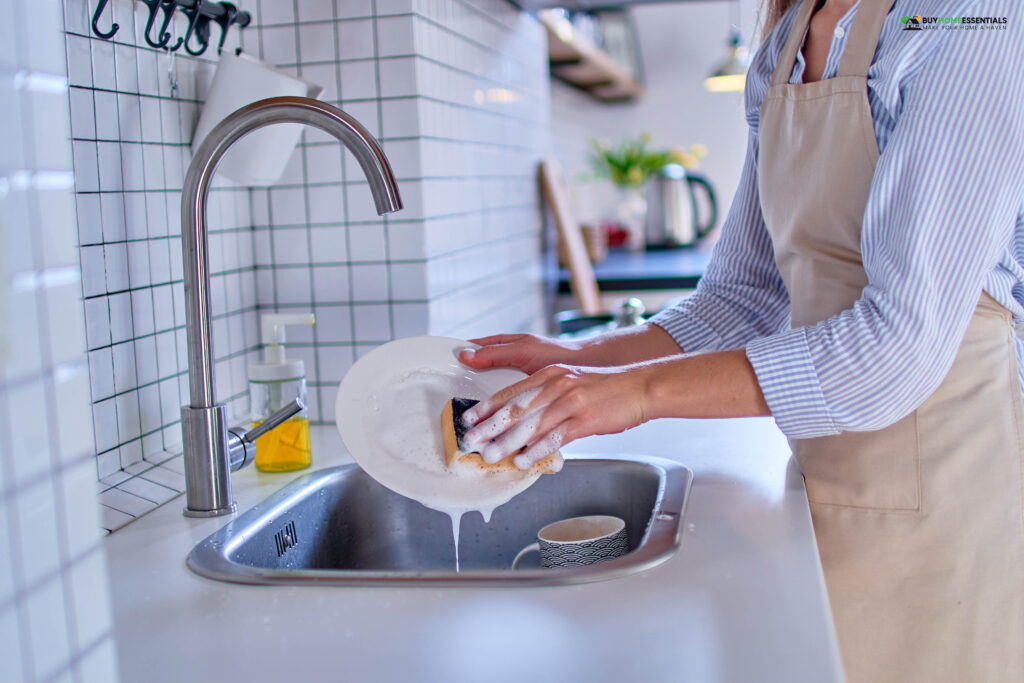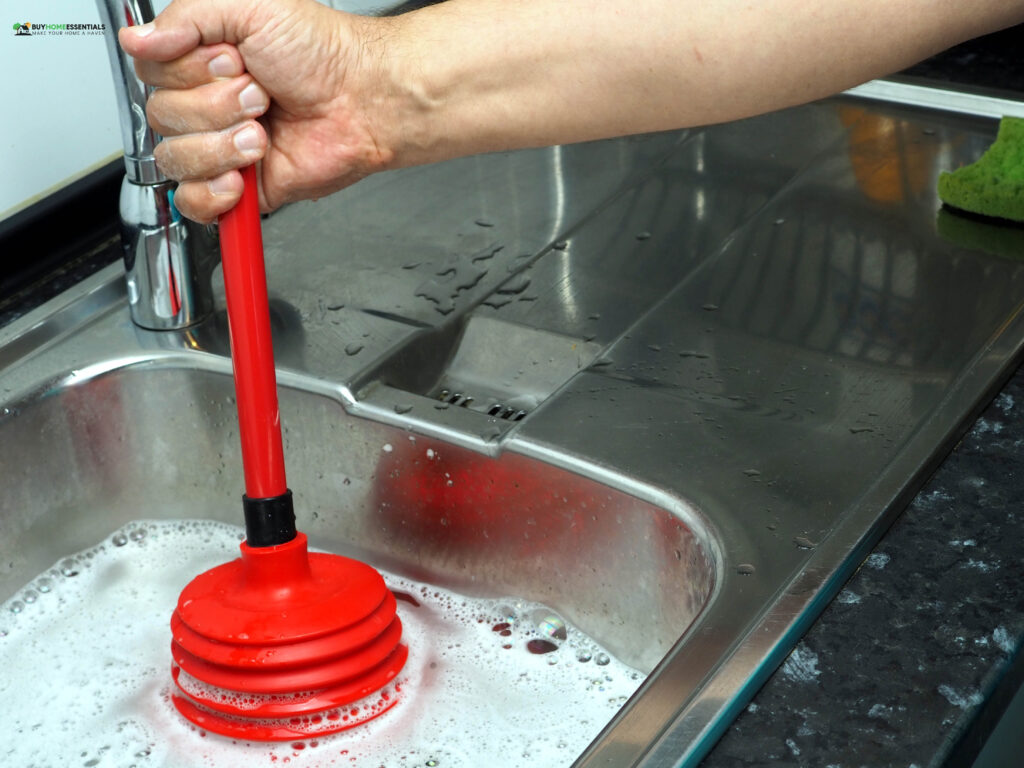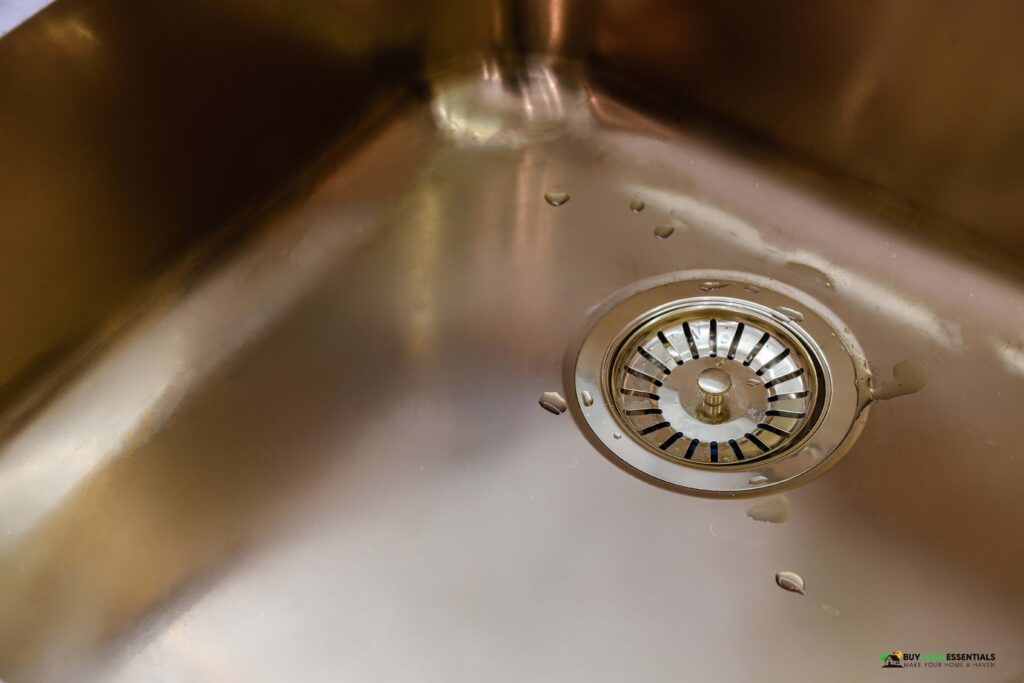Do you have a kitchen sink that just won’t drain properly? Clogged kitchen sinks can create unnecessary inconvenience and disrupt your daily routine. Thus, understanding how to unclog a kitchen sink is essential for every homeowner. This comprehensive guide will walk you through various ways to solve this common household problem.
You need a smooth-running kitchen sink to keep your kitchen clean and functional. The sink is a hub of daily activities, from washing dishes to preparing food. However, when a clog occurs, it can quickly turn into a nuisance. Explore the causes of a clogged sink and practical solutions to unclog a kitchen sink.
Causes of a Clogged Kitchen Sink

You can experience frustration when your kitchen sink gets clogged. Effectively addressing and preventing clogged sinks requires understanding their causes. Let’s examine the primary causes of kitchen sink clogs.
1. Food Waste Buildup
One of the main reasons for a clogged kitchen sink is the accumulation of food particles and scraps. As you rinse your dishes and cookware, tiny bits of food can get trapped in your drain, building up and eventually clogging it.
2. Grease and Oil
Putting grease and oil down the sink might seem convenient, but it contributes to clogs. When grease cools, it solidifies, adhering to the walls of pipes and narrowing the passage for water.
3. Foreign Objects
When paper towels, small utensils, or non-food items are disposed of down the sink, they can cause blockages. The accumulation of these objects can impede the smooth flow of water.
Unclog a Kitchen Sink: Tools and Materials You Need
After identifying the causes of clogged kitchen sinks, let’s focus on how you can resolve the problem. Before starting, make sure you gather all the necessary tools and materials. Here’s what you’ll need:
Tools
Materials
- Baking Soda
- Vinegar
- Boiling Water
How to Unclog a Kitchen Sink: Best Ways
These are some of the best ways to unclog a kitchen sink that you should be aware of.
How to Unclog a Kitchen Sink With Plunger

Using a plunger, you can usually clear minor clogs in your kitchen sink easily and quickly. Here’s a step-by-step guide on how to use a plunger to unclog your sink:
Step 1: Fill the Sink with Water
Fill the sink with enough water to cover the plunger’s bell. The water creates a seal and improves the effectiveness of the plunging action.
Step 2: Position the Plunger
Place the plunger over the drain, ensuring it covers the entire drain opening. Submerge the plunger’s bell in water.
Step 3: Plunge Gently but Firmly
Press gently but firmly on the plunger and plunge upward and downward. The plunger should dislodge the clog by creating pressure and suction.
Step 4: Repeat if Necessary
If necessary, repeat the plunging motion several times. You’ll hear the water drain if it’s loosening from the clog.
Step 5: Test the Drain
When the water drains freely, remove the plunger carefully and run the water once again to confirm that the clog is gone.
How to Unclog a Kitchen Sink Naturally
You can break down a clogged kitchen sink with baking soda and vinegar if you prefer natural, chemical-free solutions. Check out this step-by-step guide to using these household items:
Step 1: Gather the Materials
Ensure you have baking soda and vinegar on hand. You’ll also need boiling water.
Step 2: Pour Baking Soda Down the Drain
Start by pouring about half a cup of baking soda down the clogged drain.
Step 3: Add Vinegar
Add one cup of vinegar to a cup of hot water after you have added the baking soda. Pour it down the drain.
Step 4: Let the Mixture Work
The baking soda and vinegar mixture will take a little while to fizz and work through the clog. The chemical reaction will help break down the obstruction.
Step 5: Flush with Boiling Water
After about 15-30 minutes, carefully pour boiling water down the drain to wash away the dissolved clog and any remaining residue.
For minor to moderate clogs, this natural remedy works well.
How to Unclog a Kitchen Sink With Drain Snake
Try a drain snake or auger when a plunger doesn’t work, or you can’t resolve a stubborn clog with natural remedies. Here’s a step-by-step guide to using them:
Step 1: Prepare the Drain Snake
- For Handheld Drain Snake: Uncoil the snake and ensure the tip is free and not tangled.
- For a Power Auger: Follow the manufacturer’s instructions to set up the power auger and attach the appropriate bit.
Step 2: Insert the Snake into the Drain
Insert the tip of the snake into the clogged drain, turning the handle clockwise to advance it further into the pipe.
Step 3: Rotate and Push
Rotate the handle and push the snake into the drain while maintaining a steady, gentle pressure. It helps the snake break through the clog and navigate the pipe.
Step 4: Feel the Resistance
Upon reaching the clog, you may encounter some resistance. Continually rotate and push the snake until it breaks through or hooks onto the clog.
Step 5: Retrieve the Clog
Once you’ve broken through the clog, slowly retract the snake, taking the clog with it. Wipe off any debris and dispose of it properly.
Step 6: Test the Drain
Finally, run water down the drain to ensure the clog has been cleared. You can clear tough clogs in your kitchen sink with a drain snake or auger.
Seek For Professional Help
You might need a professional plumber to unclog a kitchen sink, especially if the clog persists. Here are the signs that it might be time to seek professional assistance:
- Recurring Clogs: If your sink clogs frequently, it may indicate a more severe problem with your plumbing system.
- Foul Odors: Persistent unpleasant smells from your sink could indicate a severe pipe blockage.
- Slow Draining: Even if you have tried several unclogging methods, a significant blockage in your sink may require professional assistance.
- Multiple Clogged Fixtures: If you have multiple clogged fixtures (sinks, bathtubs, toilets) with drainage issues simultaneously, you might have a more significant plumbing issue.
Advantages of Hiring a Professional Plumber
- Expertise: Professional plumbers have the knowledge and experience to efficiently diagnose and address complex plumbing issues.
- Specialized Equipment: Plumbers have access to advanced tools and equipment that can remove severe clogs and identify underlying issues.
- Permanent Solutions: Plumbing professionals can prevent future clogs and keep your plumbing system running smoothly.
Choosing a Reliable Plumbing Service
Ensure a plumber has good ratings, is licensed, insured, and has a good reputation. You can get recommendations from friends, family, or online platforms.
It’s essential to prioritize your safety and your plumbing system’s integrity. You can save money, time, and damage to your home by seeking professional help when needed.
Best Practices to Prevent Kitchen Sink Clogs
The following are some of the best tips to prevent your kitchen sink clogs.
Dispose of Food Wisely
The best way to prevent clogs in your kitchen sink is to dispose of food waste properly. Don’t put large food scraps or oils down the drain. Scrap them into the trash or compost bin instead.
Use a Sink Strainer

A practical sink strainer can make all the difference. Sink strainers catch food particles and debris before they enter the drain, reducing the risk of blockages. It’s an affordable and effective preventive measure.
Regular Hot Water Flush
A simple yet effective method of preventing clogs is regularly running hot water down the drain. Hot water helps dissolve grease and clear pipes, preventing blockages from building up.
Periodic Baking Soda and Vinegar Treatment
Another helpful practice is the periodic use of baking soda and vinegar. It helps break down accumulated residue and keeps the pipes clear.
Avoid Putting Non-Food Items Down the Drain
You should avoid flushing non-food items down the drain. You should only flush water and small food particles down the drain. Dispose of paper towels and small non-food items properly to avoid clogs.
Monitor and Maintain Your Garbage Disposal
It is essential to monitor and maintain your garbage disposal regularly. Ensure it is clean and free of fibrous or hard items that could clog it. Well-maintained garbage disposals will contribute to a smoothly running sink.
Regular Professional Maintenance
Finally, consider scheduling periodic inspections with a professional plumber. Detecting potential problems early on and providing maintenance tips can reduce the chance of clogs.
You can significantly reduce the likelihood of kitchen sink clogs by using these preventive measures as part of your routine.
Related: How to Clean Kitchen Sink Drain
The Takeaway
That’s all from today’s round-up on how to unclog a kitchen sink. Keep your kitchen sink clear and functional for seamless daily routines. Now that you know the causes of clogs, you can employ effective unclogging methods and adopt preventive measures to resolve sink-related issues.
Keep in mind that a well-maintained sink makes daily activities run smoothly. Take action today, implement these solutions, and enjoy an optimized kitchen sink.





